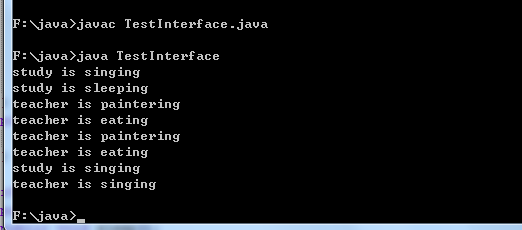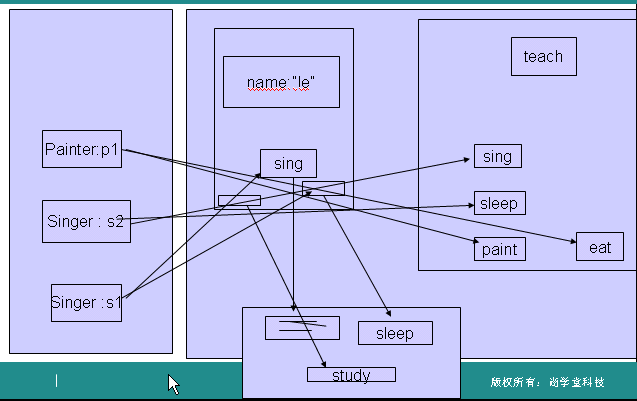介面
1、多個無關的類可以實現同一個介面
2、一個類可以實現多個無關的介面
3、與繼承關係類似,介面與實現類之間存在多型性
4、定義java類的語法格式
< modifier> class < name>[extends< superclass>][implements< interface>[, interface]*]{
<declarations>*
}
附:
1、介面(interface)是抽象方法和常亮值的定義的結合。
2、從本質上講,介面是一種特殊的抽象類,這種抽象類中只包含常亮和方法的定義,而沒有變數和方法的實現。
3、介面定義舉例:
public interface Runner{ public static final int id = 1; public void strrt(); public void run(); public void stop(); }
介面特性:
1、介面可以實現多重繼承
2、介面宣告的屬性預設為public static final 的;也只能是public static final 的;
3、介面中只能定義抽象方法,而且這些方法預設為public 的、也只能是public的;
4、介面可以繼承其他介面,並新增新的屬性和抽象方法;
介面的使用以及介面實現多型:
public class TestInterface{ public static void main(String args[]){ Singer student = new Student("studentName"); student.sing(); student.sleep(); Teacher teacher = new Teacher("TeacherName"); teacher.painter(); teacher.eat(); Painter painter = (Painter)teacher; painter.painter(); painter.eat(); //下面是實現多型的部分 TestInterface t1 = new TestInterface(); t1.f(student); t1.f(teacher); } public void f(Singer s){ s.sing(); } } interface Singer{ public void sing(); public void sleep(); } interface Painter{ public void painter(); public void eat(); } class Student implements Singer{ private String name; public Student(String name){ this.name = name; } public String getName(){ return name; } public void Study(){ System.out.println("studying..."); } public void sing(){ System.out.println("study is singing"); } public void sleep(){ System.out.println("study is sleeping"); } } class Teacher implements Singer,Painter{ private String name; public Teacher(String name){ this.name = name; } public String getName(){ return name; } public void sing(){ System.out.println("teacher is singing"); } public void sleep(){ System.out.println("teacher is sleeping"); } public void painter(){ System.out.println("teacher is paintering"); } public void eat(){ System.out.println("teacher is eating"); } }
執行結果:

記憶體分析圖:

示例:下面實現了一個三種不同的人給動物餵食和玩的多型,用介面實現。
public class TestDynamic{ public static void main(String args[]){ HelpAnimal farmer = new Farmer("farmer"); HelpAnimal worker = new Worker("worker"); HelpAnimal goverment = new Goverment("goverment"); TestDynamic test = new TestDynamic(); test.f(farmer); test.f(worker); test.f(goverment); } public void f(HelpAnimal animal){ animal.play(); animal.eat(); } } interface HelpAnimal{ public void eat(); public void play(); } class Farmer implements HelpAnimal{ private String name; public Farmer(String name){ this.name = name; } public void eat(){ System.out.println("Farmer eat"); } public void play(){ System.out.println("Farmer play"); } } class Worker implements HelpAnimal{ private String name; public Worker(String name){ this.name = name; } public void eat(){ System.out.println("Worker eat"); } public void play(){ System.out.println("Worker play"); } } class Goverment implements HelpAnimal{ private String name; public Goverment(String name){ this.name = name; } public void eat(){ System.out.println("Goverment eat"); } public void play(){ System.out.println("Goverment play"); } }